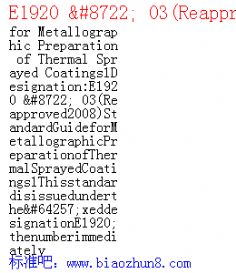E1920 − 03(Reapproved2008) Thermal Sprayed Coatings

Standard Guide for Metallographic Preparation of Thermal Sprayed Coatings1
Designation:E1920 − 03(Reapproved2008)
StandardGuidefor
MetallographicPreparationofThermalSprayedCoatings1
ThisstandardisissuedunderthefixeddesignationE1920;thenumberimmediatelyfollowingthedesignationindicatestheyearof
originaladoptionor,inthecaseofrevision,theyearoflastrevision.Anumberinparenthesesindicatestheyearoflastreapproval.A
superscriptepsilon(´)indicatesaneditorialchangesincethelastrevisionorreapproval.
1.Scope
1.1Thisguidecoversrecommendationsforsectioning,
cleaning,mounting,grinding,andpolishingtorevealthe
microstructuralfeaturesofthermalsprayedcoatings(TSCs)
andthesubstratestowhichtheyareappliedwhenexamined
microscopically.Becauseofthediversityofavailable
equipment,thewidevarietyofcoatingandsubstrate
combinations,andthesensitivityofthesespecimenstoprepa-
rationtechnique,theexistenceofaseriesofrecommended
methodsformetallographicpreparationofthermalsprayed
coatingspecimensishelpful.Adherencetothisguidewill
providepractitionerswithconsistentandreproducibleresults.
Additionalinformationconcerningstandardpracticesformet-
allographicpreparationcanbefoundinPractice E3.
1.2 Thisstandarddoesnotpurporttoaddressallofthe
safetyconcerns,ifany,associatedwithitsuse.Itisthe
responsibilityoftheuserofthisstandardtoestablishappro-
priatesafetyandhealthpracticesanddeterminetheapplica-
bilityofregulatorylimitationspriortouse.
2.ReferencedDocuments
2.1 ASTMStandards:
2
E3 GuideforPreparationofMetallographicSpecimens
E7 TerminologyRelatingtoMetallography
3.Terminology
3.1 Definitions—Fordefinitionsoftermsusedinthisguide,
seeTerminology E7.
3.2 DefinitionsofTermsSpecifictoThisStandard:
3.2.1 lineardetachment,n—aregionwithinaTSCinwhich
twosuccessivelydepositedsplatsofcoatingmaterialhavenot
metallurgicallybonded.
3.2.2 splat,n—anindividualglobuleofthermalsprayed
materialthathasbeendepositedonasubstrate.
3.2.3 tapermount,n—ametallographicspecimencreatedby
mountingafeature,typicallyaninterfaceorthincoating,ata
smallangletothepolishingplane,suchthatthevisiblewidth
exhibitedbythefeatureisexpanded.
3.2.4 TSC,n—thermalsprayedcoating,including,butnot
limitedto,thoseformedbyplasma,flame,andhighvelocity
oxyfuel.
4.SignificanceandUse
4.1TSCsareusedinanumberofcriticalindustrialcompo-
nents.TSCscanbeexpectedtocontainmeasurablelevelsof
porosityandlineardetachment.Accurateandconsistentevalu-
ationofspecimensisessentialtoensuretheintegrityofthe
coatingandproperadherencetothesubstrate.
4.1.1 Example1: Byuseofinappropriatemetallographic
methods,theapparentamountofporosityandlineardetach-
mentdisplayedbyagivenspecimencanbeincreased,by
excessiveedgerounding,ordecreasedbysmearingofmaterial
intovoids.Thereforeinaccuratelevelsofporosityandlinear
detachmentwillbereportedevenwhentheaccuracyofthe
measurementtechniqueisacceptable.
4.1.2 Example2: Inconsistentmetallographicpreparation
methodscancausetheapparentamountofvoidstovary
excessivelyindicatingapoorlycontrolledthermalspray
process,whiletheuseofconsistentpracticewillregularly
displaythetruemicrostructureandverifytheconsistencyof
thethermalsprayprocess.
4.2DuringthedevelopmentofTSCprocedures,metallo-
graphicinformationisnecessarytovalidatetheefficacyofa
specificapplication.
4.3Crosssectionsareusuallytakenperpendiculartothe
longaxisofthespecimenandpreparedtorevealinformation
concerningthefollowing:
4.3.1Variationsinstructurefromsurfacetosubstrate,
4.3.2Thedistributionofunmeltedparticlesthroughoutthe
coating,
4.3.3Thedistributionoflineardetachmentthroughoutthe
coating,
4.3.4Thedistributionofporositythroughoutthecoating,
4.3.5Thepresenceofcontaminationwithinthecoating,
4.3.6Thethicknessofthecoating(topcoatandbondcoat,
whereapplicable),
4.3.7Thepresenceofinterfacialcontamination,
1
ThisguideisunderthejurisdictionofASTMCommittee E04 onMetallography
andisthedirectresponsibilityofSubcommittee E04.01 onSpecimenPreparation.
CurrenteditionapprovedOct.1,2008.PublishedJanuary2009.Originally
approvedin1997.Lastpreviouseditionapprovedin2003asE1920–03.DOI:
10.1520/E1920-03R08.
2
ForreferencedASTMstandards,visittheASTMwebsite,www.astm.org,or
contactASTMCustomerServiceatservice@astm.org.For AnnualBookofASTM
Standards volumeinformation,refertothestandard’sDocumentSummarypageon
theASTMwebsite.
Copyright©ASTMInternational,100BarrHarborDrive,POBoxC700,WestConshohocken,PA19428-2959.UnitedStates
1 Copyright by ASTM Int'l (all rights reserved); Wed Jan 9 03:36:43 EST 2013
Downloaded/printed by
Norheastern University pursuant to License Agreement. No further reproductions authorized.
This standard is for EDUCATIONAL USE ONLY.4.3.8Theintegrityoftheinterfacebetweenthecoatingand
substrate,and,
4.3.9Theintegrityofthecoatingmicrostructurewithre-
specttochemistry.
5.SelectionofMetallographicSpecimens
5.1Selectionofspecimensformetallographicexamination
iscriticaliftheirinterpretationistobeofvalue.Specimens
mustberepresentativeofthecoating.Generally,theplaneof
polishshouldbenormaltothecoatingsurfacesoastodisplay
theentirecoatingthickness,thesubstrate,andallinterfaces.
6.Sectioning
6.1Specimenstobemountedformetallographicprepara-
tionaregenerallynotlargerthan12mmby25mm(0.5by1.0
in.).Theheightofthemountedspecimenshouldbenogreater
thannecessaryforconvenienthandlingduringpolishing.
6.2InsectioningTSCspecimens,caremustbeexercisedto
avoidaffectingthesoundnessofthecoatingandtheinterface
betweenthecoatingandthesubstrate.Sectioningdamageof
thecoatingandinterfacethatcannotberemovedbysubsequent
grindingandpolishingmustbeavoided.
6.2.1Friable,porous,orbrittlecoatingstobesectionedmay
bevacuumimpregnatedwithepoxymountingcompound
beforesectioningtoprotectthespecimen.
6.2.2Specimensshouldalwaysbesectionedsuchthatthe
coatingiscompressedintothesubstrate.Sectioningtechniques
whichplacethecoatingandinterfaceintensionarestrictlyto
beavoided.Sectioningintensionmaycausethecoatingtobe
pulledawayfromthesubstrateorresultindelaminationofthe
coating.Duringexaminationofthepolishedspecimens,itis
likelythatthistypeofdamagewillbemistakenlyinterpreted.
Whensectioningsomespecimens,itmaynotbepossibleto
avoidplacingsomeareasoftheTSCintension.Theseareas
shouldbenotedandnotincludedintheevaluationofthe
specimen.
6.2.3Sectioningwithahacksawwillproducesignificant
damagetothecoatingandinterfaceandisnotconsidered
acceptable.
6.2.4Usinganabrasivecutoffbladewithalargeparticle
sizeabrasiveproducesasmoothersurfacethanahacksaw,but
stillproducescoatingdamagethatmayrequireconsiderable
grindinginsubsequentpreparationtoremove.Thechoiceof
cutoffwheel,coolant,cuttingconditions,andthetypeand
hardnessofthecoatingandsubstratewillinfluencethequality
ofthecutsurface.Apoorchoiceofcuttingconditionscan
easilyoverheatsomeTSCspecimensrenderingthespecimens
unusableforproperevaluation.
6.2.5Sectioningcanbecompletedwithminimaldamageto
thecutsurfacebyselectionofoneofthetwofollowing
abrasivecutoffblades:
6.2.5.1Useadiamondwaferingbladewithamaximum
thicknessof0.63mm(0.025in.).
6.2.5.2Useanultra–thinaluminumoxideabrasiveblade
approximately0.76mm(0.030in.)thick,whichwillbreak
downduringcuttingtohelpreducesectioningdamage.
6.2.6Fasterbladespeeds,1675m/min.(5500surfaceft/
min.)orgreater,producelesscoatingdamage.Slowerblade
speedswillresultinmoredamagetothecutsurfaceandarenot
recommended.
6.2.7Generally,anabrasivecutoffbladeselectedtocutthe
substrateeffectivelywillbethebestbladeforthecombination
ofTSCandsubstrate.
7.Cleaning
7.1Cleaningofspecimenspriortomountingisessential.
Allsectioningcoolantshallberemovedfromthesurfaceand
fromanyporosityconnectedtothesurface.Useofanorganic
solventtoaidinfluidremovalandthoroughdryingisneces-
sary.Dryinginanovenatlowtemperature(60to80°Cor140
to176°F)canacceleratethisprocess.Anyliquidresidualmay
impedeimpregnationofporosity,aswellasretardthecuringof
mountingcompoundscausingdifficultyduringgrindingand
polishing.
7.2UltrasoniccleaningofTSCspecimensisgenerallynot
recommended,especiallyforfragileorbrittlecoatings,because
coatingparticlesmaybelostduringthisenergeticcleaning
process.Ifultrasoniccleaningisfoundtobenecessary,
cleaningtimeshouldbekepttoaminimum.
8.Mounting
8.1 GeneralInformation:
8.1.1ItisalwaysnecessarytomountTSCspecimensto
maintaintheoriginalstructureofthespecimenduringgrinding
andpolishing.Bothcompressionmountingandcastable
mountingcompoundsarecommonlyusedwhenmountingTSC
specimens.However,onlycastableepoxymountingcom-
poundsshouldbeusedintheinitialdeterminationofthetrue
characteristicsofacoatingbeforeconsideringtheuseofany
othermountingcompound.ForsomeTSCspecimenscastable
epoxymayprovidetheonlyacceptablemount.Referto Table
1 and Table2 andPractice E3 forcharacteristicsofvarious
mountingcompounds.
8.1.2Byplacingpairsofspecimensinthesamemount,time
andexpensecanbesaved.Whenusingthismountingmethod,
TABLE1CharacteristicsofCompressionMountingCompounds
TypeofCompoundA Characteristics
AcrylicCuretime10to15min.,opticallyclear,thermoplastic,
goodimpregnation,lowhardness,degradedbyhot
etchants
DiallylphthalateCuretime5to10min.,opaque,thermosetting,minimal
shrinkage,goodresistancetoetchants,highhardness
EpoxyCuretime5to10min.,opaque,thermosetting,minimal
shrinkage,goodresistancetoetchants,highhardness,
goodimpregnation
PhenolicCuretime5to10min.,opaque,thermosetting,
shrinkageduringcurecanleavecreviceatspecimen
interface,degradedbyhotetchants,moderate
hardness
AThesecompoundsoftencontainfillermaterials,suchasglassfibersormineral
particulate.
E1920−03(2008)
2 Copyright by ASTM Int'l (all rights reserved); Wed Jan 9 03:36:43 EST 2013
Downloaded/printed by
Norheastern University pursuant to License Agreement. No further reproductions authorized.
This standard is for EDUCATIONAL USE ONLY.thetwocoatedsurfacesshouldfaceeachother.Itmaybe
possibletoplacemorethanonepairofspecimensinasingle
mount.
8.1.3Mountingexpensesmaybereducedbyemployingthe
sandwich mounttechnique.Asandwichmountismadeby
usingasmallamountofabetter,moreexpensive,mounting
compoundasthecriticallayerincontactwiththespecimenand
thentoppingoffthemountwithalessexpensivecompound.
Caremustbetakentouseonlymountingmaterialsthatare
compatible.
8.1.4Tapermountingmaybeusefulforexaminationofthe
interfacesbetweenbondcoatingandtopcoating,aswellas
betweencoatingandsubstrate.
8.1.5Allcomponentsofmountingcompoundsincluding
resinsandcatalysts,aswellasanydyesorcolorants,shouldbe
handledinaccordancewiththemanufacturer’sinstructions.
MaterialSafetyDataSheetsareavailablefromthemanufac-
turer.
8.2 CompressionMountingCompounds:
8.2.1Curingofcompressionmountingcompoundsisac-
complishedbytheuseofaheatedpressdesignedforand
dedicatedtometallographicmounting.Compressionmounting
compoundsrequiretheuseofheat(140to150°Cor284to
302°F)andpressure(upto29MPaor4200psi)toproperly
curethemount.Therefore,mountingcompoundsofthistype
shouldonlybeusedtomountdense,non–friablecoatingswith
substratesaminimumof1.5mm(0.060in.)thick.
8.2.2Compressionmountsshouldbecooledtobelow40°C
(104°F)whileunderpressure,preferablybyuseofawater
cooledmountingpress,topreventformationofacrevice
betweenthemountingcompoundandthespecimenasthey
contractunevenlyduringcooling.
8.3 CastableMountingCompounds:
8.3.1Castablemountingcompoundsmaybeusedforall
TSCspecimens,butareparticularlyusefulforporousspeci-
mens.Thesemountingcompoundsareusuallypreparedby
mixingtwocomponentsjustpriortouse.Thespecimenis
placedinamold,usuallyacuporringform,intowhichthe
compoundispoured.
8.3.2Vacuumimpregnationofporousspecimenswithan
epoxyresinisrequired.Thespecimenandmoldareputintoa
vacuumchamberwhichwillallowthecastableepoxytobe
pouredintothemoldafterthechamberhasbeenevacuated.
Vacuumpressureshouldbeintherangeof630to760mm(25
to30in.)ofmercury.Thevacuumshouldbemaintainedfor
abouttwototenminbeforeallowingairintothechamber.Low
viscosityepoxyresinsarerecommendedforbestresultsduring
vacuuminfiltrationandsubsequentpreparationofTSCspeci-
mens.
8.3.3Additionoffluorescentdyes (1) orotheragents,such
asRhodamineB (2),thatproducecolorresponseuponfluo-
rescentexcitationorwithcrossedpolarizedillumination,
respectively,tothecastablecompoundduringmixingwillaid
intheidentificationofimpregnatedporosityduringmicro-
scopicalexamination.
8.3.4Careshouldbeusedwhenhandlingcastablemounting
compounds.Supplier’sinstructionsfortheuseandhandlingof
thesematerialsshouldbefollowed.
9.GrindingandPolishing
9.1DuetothemanydifferenttypesofTSCsandsubstrate
materials,grindingandpolishingsequenceswillvary.Proper
choiceofpolishingsurface,lubricant,abrasivetypeandsize,
time,force,polishingwheelspeedandrelativerotationwill
produceaccurateandconsistentresults.SomeTSCsmay
requirespecializedpreparationtechniques.However,many
coatingscanbepreparedonautomaticandsemi–automatic
polishingequipmentbyuseofoneofthethreeprocedures
listedin Table3, Table4,and Table5.
9.1.1Useofautomaticandsemi–automaticpolishingequip-
menthasbeenfoundtoreduceinconsistencyinpolished
specimensandisthereforerequiredinthemetallographic
preparationforTSCspecimens.Thesemachinesprovidere-
producibilityinwheelspeed,specimenpositiononthewheel,
appliedpressure,relativerotation,andpolishingtime.Manual
grindingandpolishingisnotrecommendedbecauseofthe
inherentinconsistencyandthesensitivityofthesespecimensto
preparationtechnique. (3,4,5,6)
9.1.2Mostoftheequipmentforautomaticandsemi–auto-
maticgrindingandpolishingmovethespecimenarounda
rotatingwheelcoveredwithabrasivesothatthespecimen
followsanepicycloidalpath.Thescratchpatternconsistsof
randomarcs,anduponinspection,shouldbeuniformacross
theentirespecimensurfacebeforeproceedingtothenextstep
inthepreparationsequence.
9.1.3Eachofthemethodsoutlinedin Table3, Table4,and
Table5 requiresthefollowingfourbasicpreparationsteps:
9.1.3.1Planargrindingisusedtoremovelargeamountsof
materialrapidlyandtobringthegroupofspecimensinthe
holderintocoplanarity.Thisstepisnecessarytoavoida
situationwhereoneormorespecimensintheholderdonot
contacttheabrasivewhilethespecimensincontactreceive
excessivepressure.Planargrindingofspecimensalsoshould
removethelayerofdeformedmaterialresultingfromthe
previoussectioningoperation.
9.1.3.2Finegrindingremovesdisturbedmaterialfromthe
planargrindingstepwhileintroducingalayerofdisturbed
materialacceptableforthenextstepinthepreparationse-
quence.
9.1.3.3Roughpolishingisaccomplishedwitha3to6µm
diamondabrasive.Insomecases,whenthesurfaceofthe
TABLE2CharacteristicsofCastableMountingCompounds
TypeofCompoundCharacteristics
AcrylicCuretime8to15min,moderateshrinkage,low
hardness,opaque
EpoxyCuretime1to12h,negligibleshrinkage,lowlevelof
heatgeneratedduringpolymerization,moderate
hardness,transparent,lowviscosityformulaisbestfor
vacuumimpregnation
PolyesterCuretime30to60min,highshrinkage,peakcuring
temperatureupto120°C(248°F),moderatehardness,
transparent
Polyester–AcrylicCuretime8to15min,negligibleshrinkage,peak
curingtemperatureupto120°C(248°F),high
hardness,opaque
E1920−03(2008)
3 Copyright by ASTM Int'l (all rights reserved); Wed Jan 9 03:36:43 EST 2013
Downloaded/printed by
Norheastern University pursuant to License Agreement. No further reproductions authorized.
This standard is for EDUCATIONAL USE ONLY.specimenisevaluatedfollowingroughpolishing,thesurface
maybeacceptableandthefinalpolishingstepisnotneeded.
9.1.3.4Finalpolishingisaccomplishedwithcolloidalsilica
oraluminumoxideabrasive,both0.04to0.06µminsize.
10.Report
10.1Thelaboratoryreportshouldincludethedetailsand
exceptionsofthemetallographicpreparationtechniqueneeded
toreproducethemicrostructureexhibitedbytheprepared
specimen.
11.PrecisionandBias
11.1Itisnotpossibletospecifytheprecisionorbiasofthis
guidebecausenoquantitativeresultsareproduced.However,
quantitativeanalysesofthermallysprayedspecimensmaybe
influencedbythepreparationtechnique.
12.Keywords
12.1flamespray;flamesprayedcoating;highvelocity
oxy–fuelcoatings;HVOFcoatings;metallography;plasma
spray;plasmasprayedcoatings;specimenpreparation,metal-
lographic;thermalsprayedcoatings;thermalspray
TABLE3PreparationMethodI—SiliconCarbideAbrasivePaperGrinding
Surface
Coolant/
Lubricant
AbrasiveSize/Type
ANSI
A [FEPA]
B Time,s ForceC ,
n[lbs]
SurfaceSpeed,
RPM RelativeRotation
PlanarGrinding
PaperWater180[P180]gritSiC15–2520–30[4.5–6.7]200–300ComplementaryD
FineGrinding
PaperWater240[P220]gritSiC15–2520–25[4.5–5.6]200–300Complementary
PaperWater320[P500]gritSiC15–2520–25[4.5–5.6]200–300Complementary
PaperWater600[P1200]gritSiC15–2520–25[4.5–5.6]200–300Complementary
PaperWater800[P2400]gritSiC15–2520–25[4.5–5.6]200–300Complementary
RoughPolishing
No/LowNapClothLappingoilor
Extendingfluid
3–6µmdiamond120–30020–30[4.5–6.7]100–150Complementary
FinalPolishing
SyntheticSuedeNone
----------
Water
E
ColloidalSilica
---------
0.04–0.06µmAl2O3
60–12010–20[2.2–4.5]100–150ContraryF
AAmericanNationalStandardsInstitute(ANSI)designationofgritsize.
BFederationofEuropeanProducersofAbrasives(FEPA)designationofgritsize.
CForceper32mm(1.25in.)diameterspecimen.
DComplementaryrotation,surfaceandspecimensspininsamedirection.
EWaterfreeofparticulateisusedasanextender/diluent,distilledwaterisrecommended.
F
Contraryrotation,surfaceandspecimensspininoppositedirections.
TABLE4PreparationMethodII—DiamondGrinding
Surface
Coolant/
Lubricant
AbrasiveSize/Type
ANSI
A [FEPA]
B Time,min ForceC ,
n[lbs]
SurfaceSpeed,
RPM RelativeRotation
PlanarGrinding
PaperWater240[P220]gritSiC0.25–0.520–30[4.5–6.7]250–350ComplementaryD
FineGrinding
HardWovenClothWater–base
Suspension
6–9µmdiamond4–720–25[4.5–5.6]100–150Complementary
RoughPolishing
No/LowNapClothLappingoilor
Extendingfluid
3µmdiamond1–320–30[4.5–6.7]100–150Complementary
FinalPolishing
SyntheticSuedeWater
E ColloidalSilica1–323–35[5.2–7.9]100–150ContraryF
AAmericanNationalStandardsInstitute(ANSI)designationofgritsize.
BFederationofEuropeanProducersofAbrasives(FEPA)designationofgritsize.
CForceper32mm(1.25in.)diameterspecimen.
DComplementaryrotation,surfaceandspecimensspininsamedirection.
EWaterfreeofparticulateisusedasanextender/diluent,distilledwaterisrecommended.
F
Contraryrotation,surfaceandspecimensspininoppositedirections.
E1920−03(2008)
4 Copyright by ASTM Int'l (all rights reserved); Wed Jan 9 03:36:43 EST 2013
Downloaded/printed by
Norheastern University pursuant to License Agreement. No further reproductions authorized.
This standard is for EDUCATIONAL USE ONLY.REFERENCES
(1) Street,KennethW.,andLeonhardt,ToddA.,“FluorescenceMicros-
copyfortheCharacterizationofStructuralIntegrity,” NASATechnical
Memorandum105253,1991.
(2) Geary,A.R.,“MetallographicEvaluationofThermalSpray
Coatings,” TechnicalMeetingofthe24thAnnualConvention:Inter-
nationalMetallographicSociety,July1991,Monterey,CA,pp.
637–650.
(3) Ruchert,Michael,“PlasmaSprayCoatingSymposium,” Structure,
Struer’sMetallographicNews No.20,1989,pp.15–18.
(4) Glancy,S.D.,“UniversalMetallographicProcedureforThermal
SprayCoatings,” Structure,Struer’sJournalofMaterialography No.
29,1996,pp.12–16.
(5) Sauer,J.P.,“MetallographicPreparationofThermalSprayCoatings:
CoatingSensitivityandtheEffectofPolishingIntangibles,” Proceed-
ingsfromthe9thNationalThermalSprayConference,October1996,
Cincinnati,OH,pp.777–783.
(6) Blann,G.A.,“TheImportantRoleofMicrostructuralEvaluationin
EachPhaseofThermallySprayedCoatingsApplication,” Proceed-
ingsfromtheInternationalThermalSprayConference,June1992,
Orlando,FL,pp.959–966.
ASTMInternationaltakesnopositionrespectingthevalidityofanypatentrightsassertedinconnectionwithanyitemmentioned
inthisstandard.Usersofthisstandardareexpresslyadvisedthatdeterminationofthevalidityofanysuchpatentrights,andtherisk
ofinfringementofsuchrights,areentirelytheirownresponsibility.
Thisstandardissubjecttorevisionatanytimebytheresponsibletechnicalcommitteeandmustbereviewedeveryfiveyearsand
ifnotrevised,eitherreapprovedorwithdrawn.Yourcommentsareinvitedeitherforrevisionofthisstandardorforadditionalstandards
andshouldbeaddressedtoASTMInternationalHeadquarters.Yourcommentswillreceivecarefulconsiderationatameetingofthe
responsibletechnicalcommittee,whichyoumayattend.Ifyoufeelthatyourcommentshavenotreceivedafairhearingyoushould
makeyourviewsknowntotheASTMCommitteeonStandards,attheaddressshownbelow.
ThisstandardiscopyrightedbyASTMInternational,100BarrHarborDrive,POBoxC700,WestConshohocken,PA19428-2959,
UnitedStates.Individualreprints(singleormultiplecopies)ofthisstandardmaybeobtainedbycontactingASTMattheabove
addressorat610-832-9585(phone),610-832-9555(fax),orservice@astm.org(e-mail);orthroughtheASTMwebsite
(www.astm.org).PermissionrightstophotocopythestandardmayalsobesecuredfromtheASTMwebsite(www.astm.org/
COPYRIGHT/).
TABLE5PreparationMethodIII—DiamondGrinding
Surface
Coolant/
Lubricant
AbrasiveSize/TypeTime,min ForceA ,
n[lbs]
SurfaceSpeed,
RPM RelativeRotation
PlanarGrinding
FixedDiamondDiscWater40–60µmdiamond2–420–25[4.5–5.6]250–350ComplementaryB
FineGrinding
Medium–Hard
CompositeDisc
Water–base
Suspension
6–9µmdiamond3–520–25[4.5–5.6]100–150Complementary
RoughPolishing
No/LowNapClothWater–base
Suspension
3µmdiamond1–320–30[4.5–6.7]100–150Complementary
FinalPolishing
SyntheticSuedeWater
C ColloidalSilica1–320–35[5.2–7.9]100–150ContraryD
AForceper32mm(1.25in.)diameterspecimen.
BComplementaryrotation,surfaceandspecimensspininsamedirection.
CWaterfreeofparticulateisusedasanextender/diluent,distilledwaterisrecommended.
DContraryrotation,surfaceandspecimensspininoppositedirections.
E1920−03(2008)
5 Copyright by ASTM Int'l (all rights reserved); Wed Jan 9 03:36:43 EST 2013
Downloaded/printed by
Norheastern University pursuant to License Agreement. No further reproductions authorized.
This standard is for EDUCATIONAL USE ONLY.

下载说明:
1.请先分享,再下载
2.直接单击下载地址,不要使用“目标另存为”
3.压缩文件请先解压
4.PDF文件,请用PDF专用软件打开查看
5.如果资料不能下载,请联系本站